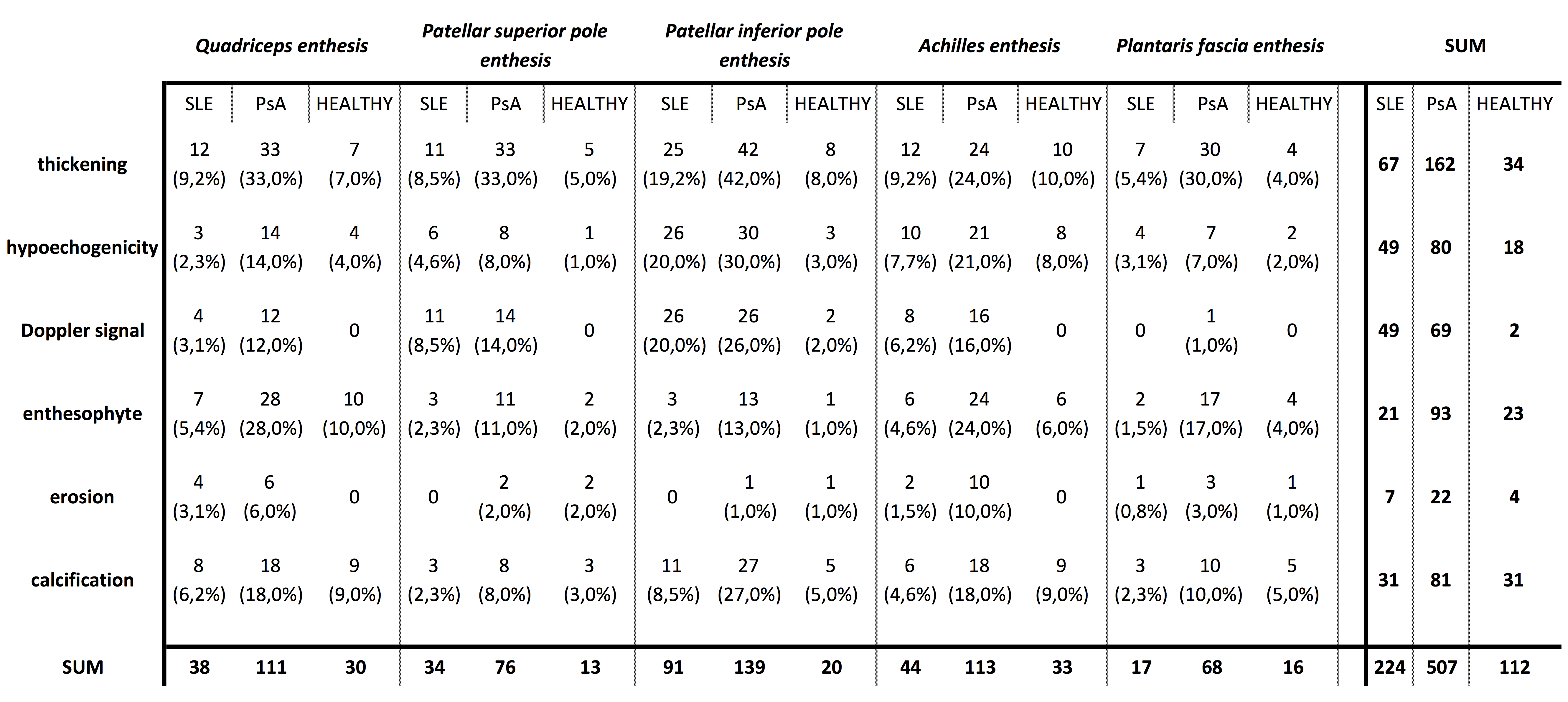Session Information
Date: Monday, November 6, 2017
Title: Systemic Lupus Erythematosus – Clinical Aspects and Treatment Poster II: Damage and Comorbidities
Session Type: ACR Poster Session B
Session Time: 9:00AM-11:00AM
Background/Purpose:
A recent study revealed ultrasound (US) findings indicative of entheseal involvement in a small group of patients with systemic lupus erytemathosus (SLE), raising the hypothesis that enthesis could be a missing target in the evaluation of musculoskeletal manifestations in SLE. With the present study, we aimed at exploring by US the prevalence and distribution of lower limb entheseal abnormalities in a larger cohort of SLE patients, comparing the US features of SLE-enthesopathy with those of psoriatic arthritis (PSA) patients and of healthy subjects. We also examined the clinical and serologic associations of SLE-enthesopathy.
Methods:
We included 165 patients: 65 with SLE, 50 with PSA and 50 healthy subjects. The physical examination and the US evaluation were performed in the same day by independent rheumatologists at the following anatomic sites: the patellar insertion of the quadriceps tendon, the proximal and distal insertions of the patellar tendon, the calcaneal insertion of the Achilles tendon and of the plantar fascia. The US pathological findings, identified according to the definition of the OMERACT US Task Force, were correlated with clinical enthesitis. US enthesitis scores, based on the scoring system proposed by D’Agostino et al., were correlated with disease activity indices, serologic and clinical parameters.
Results:
We scanned 1650 entheses: 650 in SLE patients, 500 in PSA patients and in 500 in healthy subjects. The prevalence and distribution of the US abnormalities is reported in Table 1. In the patients with SLE, the US examination revealed one or more US abnormalities in 117 out of 650 entheses (18%) and in at least one enthesis of 44 out of 65 patients (67.7%). There was no statistical difference between SLE patients and healthy subjects about the US finding indicative of entheseal structural damage (enthesophyte, erosion, calcification), whereas US findings of “active” enthesitis (Doppler signal, hypoechogenicity, entheseal thickening) were found significantly higher in SLE patients than in healthy subjects, especially at the patellar and Achilles tendon insertions. There was a weak correlation (k=0.29) between clinical enthesitis and the presence of at least one US entheseal pathological finding, which increased when clinical enthesitis was correlated only with Doppler signal (k=0.38). D’agostino enthesitis scores correlated with age (p=0.005, f2=0.2) and SLEDAI 2-k (p=0.002, f2=0.24) and BILAG-MS (p=0.008, f2=0.17).
Conclusion:
This study revealed a considerable burden of entheseal abnormalities in SLE patients, especially at the patellar and Achilles tendon entheses. The US pattern of “active” enthesitis was the most frequently detected. Entheseal involvement in SLE patients correlated with high disease activity (as documented by SLEDAI 2-k) and with more severe musculoskeletal involvement, as evaluated by MS-BILAG.
To cite this abstract in AMA style:
Di Matteo A, Filippucci E, Cipolletta E, Lato V, Hurnakova J, Satulu I, De Angelis R, Grassi W. Entheseal Involvement in Systemic Lupus Erythematosus: An Ultrasound Study [abstract]. Arthritis Rheumatol. 2017; 69 (suppl 10). https://acrabstracts.org/abstract/entheseal-involvement-in-systemic-lupus-erythematosus-an-ultrasound-study/. Accessed .« Back to 2017 ACR/ARHP Annual Meeting
ACR Meeting Abstracts - https://acrabstracts.org/abstract/entheseal-involvement-in-systemic-lupus-erythematosus-an-ultrasound-study/

